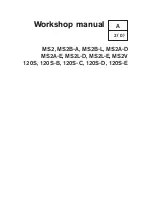
3
General instructions
Always use goggles when doing any work where
there is any risk of splinters, grinding sparks,
acid splash or other chemicals. Your eyes are
extremely sensitive, injury could cause blind-
ness!
Avoid skin contact with oil! Long-term or repeat-
ed skin contact with oil can make your skin dry
out. The consequence is irritation, dry skin, ec-
zema and other skin disorders. Used oil is more
hazardous to health than new oil. Use protective
gloves and avoid oil-soaked clothes and rags.
Wash regularly, especially before meals. Use
special skin cream to avoid drying and facilitate
skin cleaning.
Most chemicals intended for the product (e.g.
engine and transmission oils, glycol, petrol (gas-
oline) and diesel oil) or chemicals for workshop
use (e.g. degreasers, paints and solvents) are
hazardous. Read the instruction on the packag-
es carefully! Always observe the safety advise
(e.g. use of breathing protection, goggles,
gloves etc.). Make sure that other personnel are
not inadvertently exposed to hazardous sub-
stances, such as via the air they breathe. En-
sure good ventilation. Handle used and surplus
chemicals in the prescribed manner.
Be very careful when searching for leaks in the
fuel system and testing fuel injectors. Use gog-
gles. The jet from a fuel injector is under very
high pressure, and has considerable penetration
ability; fuel can force its way deep into body tis-
sues and cause serious injury. Risk of blood
poisoning (septicemia).
All fuels, and many chemicals, are flammable.
Make sure that open flames or sparks can not
set them alight. Petrol (gasoline), some thinners
and hydrogen gas from batteries are extremely
flammable and explosive when mixed with air in
the correct ratio. Do not smoke! Provide good
ventilation and take the necessary precautions
before you start welding or grinding in the vicini-
ty. Always have a fire extinguisher easily avail-
able near the workplace.
Make sure that oil and fuel soaked rags, and
used fuel and oil filters are stored in a safe
place. Oil soaked rags can self-ignite in certain
circumstances. Used fuel and oil filters are pol-
luting waste and must be handed to an approved
waste management facility for destruction, to-
gether with used lubrication oil, contaminated
fuel, paint residue, solvents, degreasers and
wash residue.
Batteries must never be exposed to open
flames or electric sparks. Do not smoke close
to the batteries. The batteries generate hydro-
gen gas when charged, which forms an explo-
sive gas when mixed with air. This gas is very
flammable and highly explosive. A spark, which
can be formed if the batteries are wrongly con-
nected, is enough to make a battery explode
and cause damage. Do not move the connec-
tions when you attempt to start the engine (risk
of arcing), and do not stand and lean over one of
the batteries.
Never mix up the battery positive and negative
poles when the batteries are installed. If the bat-
teries are wrongly connected, this can cause se-
vere damage to the electrical equipment. Please
check the wiring diagram!
Always use goggles when charging and handling
batteries. Battery electrolyte contains highly cor-
rosive sulfuric acid. If this comes into contact
with your skin, wash at once with soap and a lot
of water. If you get battery acid in your eyes,
flush at once with a generous amount of water,
and get medical assistance at once.
Stop the engine and cut the system current with
the main switch(es) before doing any work on
the electrical system.
The clutch must be adjusted with the engine
shut off.
Summary of Contents for 120S
Page 2: ......
Page 16: ...14 Design and function Reverse gear MS2 Forward position Reverse position ...
Page 17: ...15 Design and function Sailboat drive 120S Forward position Reverse position ...
Page 85: ...83 References to Service Bulletins Group No Date Refers to ...
Page 86: ...84 Notes ...
Page 88: ...7752950 1 English 01 2001 ...






































